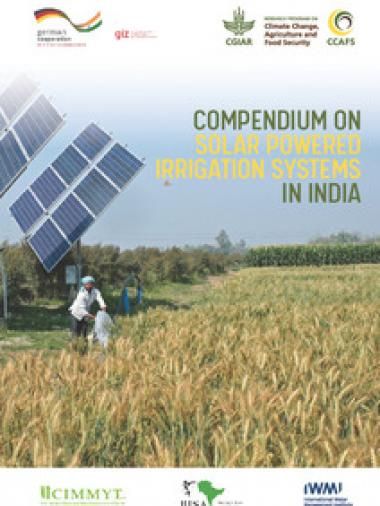Compendium on Solar Powered Irrigation Systems in India

Solar power has been one of the main focus areas in the clean energy trajectory with massive potential for application in the agriculture sector, particularly in the irrigation space. Underpinning technology and government programs have made accessing renewable energy such as solar power, very much within the reach of the communities. Solar powered irrigation system (SPIS) has been gaining the necessary impetus from development professionals and government, due to its ability to curtail climate change while supporting the economic growth of the country.
With an increasing focus on solar energy use in agriculture, several pilots and models of solar irrigation systems have been rolled out in the country. In-spite of this, the majority of the agricultural water needs are being met by electricity or diesel operated pumps. Scaling up solar irrigation mechanism has been a challenge even though Indian government is promoting them by offering heavy subsidies. Further, recent studies have shown that while some of the existing models are limiting greenhouse gas emission, some are leading to dwindling of groundwater. This rationale the need to comprehensively synthesize existing pilot initiatives, which will in-turn lead to the identification of efficient and effective models for sustainable development. It also highlights the necessity to evaluate different business and institutional models of solar irrigation system to understand factors supporting and hindering the adoption of various solar irrigation systems. With this vision of generating comprehensive knowledge on different functional solar powered smart irrigation models in India and their scalability, the CGIAR Research Program on Climate Change, Agriculture and Food Security (CCAFS), BISA-CIMMYT with support of Deutsche Gesellschaft für Internationale Zusammenarbeit (GIZ) GmbH), India has studied and documented different models of solar pumps in collaboration with the International Water Management Institute (IWMI).
The main objectives to bring forth this compendium are: to document qualitatively various deployment models of solar powered irrigation systems and to understand the factors impacting scalability of solar powered irrigation systems in India. Detailed information about the process of installation of SPIS, their usage and maintenance was collected. The different approaches have been documented in the form of case studies developed through primary and secondary research. Total 16 case studies describing different solar irrigation deployment models that are either highly popular and represent a significant portion of the solar pumps used today or they show innovations that have the potential to reach scale are documented. The compendium documents one case for centralised SPIS, two distributed SPIS and thirteen examples for decentralised systems. We tried to capture the key technical, social, institutional and financial attributes of the deployment approaches in the cases to enable comparative analysis and synthesis. This compendium brings together a collection of experiences from various geographies and from different stakeholders. The contributions are not intended to be state-of-the art academic articles but thought and discussion pieces of work in progress.
Citation
Shirsath PB, Saini S, Durga N, Senoner D, Ghose N, Verma S, Sikka A. 2020. Compendium on Solar Powered Irrigation Systems in India. CGIAR Research Program on Climate Change, Agriculture and Food Security (CCAFS).